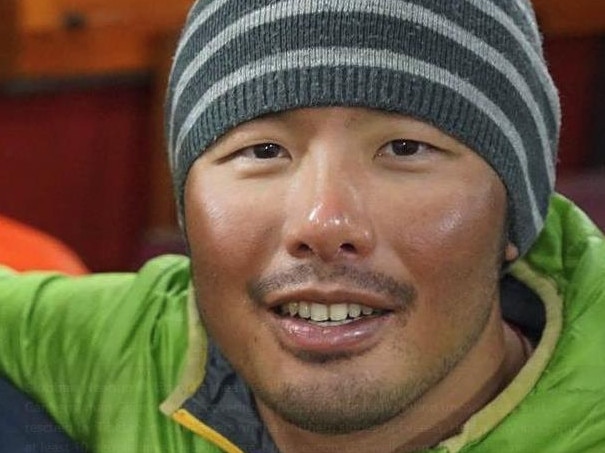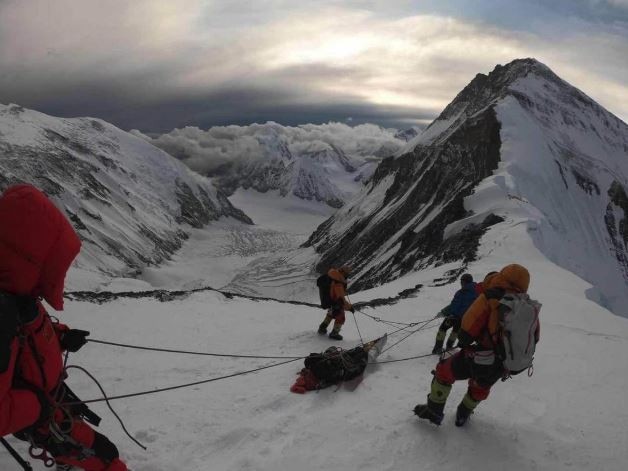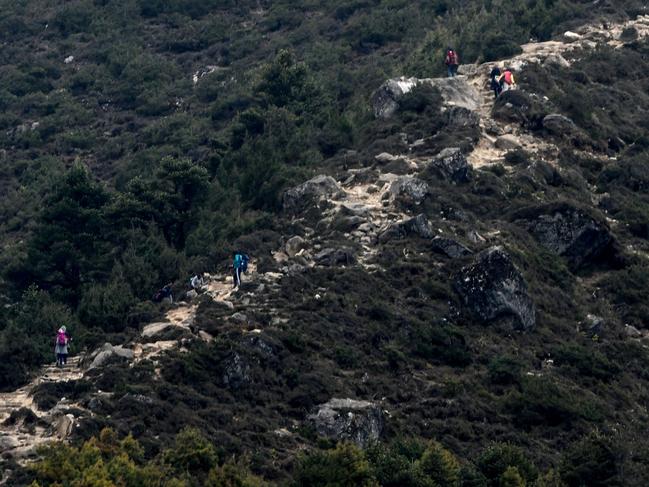Australian climber rescued on Mount Everest in hospital
The Australian man who cheated death on Mount Everest has spoken, revealing what may have gone wrong and how he’s still in bad shape in hospital. LISTEN TO OUR PODCAST
World
Don't miss out on the headlines from World. Followed categories will be added to My News.
An Australian who was stranded unconscious on Mount Everest has spoken for the first time since he was rescued after an extraordinary rescue mission involving a yak.
Canberra man Gilian Lee’s against-the-odds survival comes amid a horror climbing season, with 11 mountaineers reported dead or missing so far.
“I am alive,” he tweeted late last night.
“Something went amiss on the summit push after C2 (Camp Two). In hospital … surprisingly mum is here … which is good to get medical advice.
“Body wrecked with liver problems, no phone and vision damage. Piecing what happened. Rest.”
I am alive. Something went amiss on the summit push after C2. In hospital...surprisingly mum is here...which is good to get medical advice.
— Gilian Lee (@GilianLee) May 30, 2019
Body wrecked with liver problems, no phone and vision damage. Piecing what happened. Rest.
His miraculous rescue occurred at the 8848-metre Mount Everest peak where a team of Tibetan alpine specialists who were on the mountain doing repair work used ropes and then put him on a yak to transport him to hospital.
Mr Lee had indicated on his blog earlier he was attempting to scale the mountain without using oxygen tanks.
It was his fourth attempt to reach the summit of Mount Everest after three failed attempts in 2015, 2017 and 2018.

According to the ABC in Australia, Tashi Sherpa, a part-owner of the expedition company he paid to climb the peak, said his health was “not really good” at the 7,000 metre-mark.
““Our team guide suggest him to [go] back from the North Col but he didn’t accept and he continued to 7,600 metres,” she said.
“Italian mountaineer Jean-Marie Rossi said he saw Mr Lee and told the ABC: “[He had] so much trouble with his acclimatisation. [He was] always coughing, continuously.”
The day before, Mr Lee posted on Twitter that he’d had a “rough night” at Camp One, at an elevation of around 6000m, due to a persistent chest infection.
Australia’s Department of Foreign Affairs and Trade has refused to provide any other details about his dramatic survival story, citing privacy reasons.

The shock death toll from this year’s northern spring climbing season has put the issue of overcrowding on the iconic mountain back in the spotlight.
Climbers have shared photos taken just below the summit, showing them queued up in a tight column, waiting for their moment to push for the summit. Canadian filmmaker Elia Saikaly says he’s unlikely to ever return after watching people clamber over dead bodies, only to die themselves. “I cannot believe what I saw ... Dead bodies on the route and in tents at camp 4,” he posted on social media.
Nepal’s tourism authority has responded to the cluster of deaths by saying overcrowding is not solely the problem.
The authority’s director general Dandu Raj Ghimire said other factors were involved including only very brief windows of fine weather during which climbers could push for the summit.
Other veteran climbers have also pointed to the inexperience of some climbers and the pursuit of profits by climbing companies.
THE MOUNT EVEREST OBSESSION
The quest to conquer Mount Everest is all about the numbers. How high. How long. How many. How much.
Strip away the hype, it’s just a rock. A very tall one at that. And it’s mother nature at her most unforgiving. So human failings such as pride, ambition — and tailgating — can be brutally punished.
Everest climbing coach Alan Arnette records in his blog that as of May 27, 11 people have died so far this year in a race that has so far seen more than 825 achieve their dream.
In 1953, the first Westerner reached the summit. Naturally Edmund Hillary and his guide Tenzing Norgay felt on top of the world.
They were.
At some 8848m above sea level, the peak — known as Sagarmatha in Nepali, is the highest on the planet. And it’s still growing at about 2cm every year.
Hillary did it tough.
Modern mountaineers have it somewhat easier.
For the right price, tourists can buy the whole package: guides, porters, oxygen reserves, supply dumps, base camps and safety wires all along the well-worn path.
But money only goes so far.
It can’t compensate for inadequate fitness. It can’t tame mother nature.
It can’t buy you time.
DEADLY DESTINATION
“The third week of May 2019 may go down as one of the best and worse in Everest history,” Arnette said last week. “Over 500 people summited but it was not without cost, 10 people died, many of which were avoidable in my view...
“There are four reasons for the deaths on the Nepal side this season:
“Too many people.
“Too few summit windows.
“Too many inexperienced people climbing.
“Inadequate climber support.”
Since his post, another person - a US citizen - has died and an Australian has been rescued, unconscious.

Climbing Mount Everest is the goal of a lifetime. And it’s more attainable than ever before.
In the 1990s, international tourism firms began to explore the potential of commercial Everest climbs.
Package deals now start at some $US40,000.
In 2018, the Nepal Ministry of Tourism said it issued 347 international climbing permits. It says 261 of these achieved the summit — along with 301 ‘high-altitude workers’, or guides.
And that’s just the Nepalese side of Everest.
For the North approach, some 239 climbers are believed to have successfully summated.
For 2019, the overall figure looks to be well above 800.
It’s all thanks to improvements in clothing and breathing technology. Not to mention the immense amount of infrastructure now in place at regular intervals along the 65km climb.
Oxygen bottles. Ladders. Ropes. Tends. Stoves. Food.
Not to mention trash.
All are stacked at regular rest stops along the way.
The route is now a veritable highway.
As the traffic jams reveal.
Despite the increased convenience, there is no high-speed lane.
Avalanches, icefalls and cliffs are just the headline acts. The real challenge is much more fundamental.
RACE AGAINST TIME
The best time to climb comes during the second half of May. By June, that window of opportunity has passed.
The climb is arduous. Mostly, time is needed for mountaineers to acclimatise to the rapidly thinning atmosphere.
But not too much time.
At the summit, the atmosphere has only about one-third the pressure it does at sea level. This means every breath pulls in less air. Lungs have to work harder. Every step needs more effort.
This takes its toll on energy reserves. But it also threatens to starve the brain.

Researchers have found the human body cannot sustain itself above 5700m. The final 3150m of Everest’s climb must therefore be made on ‘borrowed’ time.
Which is why traffic jams such as that being experienced at the summit are so deadly.
When starved of oxygen, climbers’ bodies become increasingly at risk of pulmonary and cerebral oedema (accumulations of fluid), as well as blood embolisms (clots).
And then there’s frostbite.
The heart is already struggling to pump oxygenated blood around the body. So it prioritises. The oxygen — and warmth — goes to the vital organs, including the brain. Extremities, such as fingers, toes, hands and feet are the first to go without.

BOTTLENECK
There are only two main routes to the top of Everest.
From Nepal, climbers follow the Southeast Ridge — the same followed by Edmund Hillary.
From Tibet there is the North Ridge.
Both paths get narrower and more treacherous with altitude.
And both are subject to the fickle nature of the weather at the peak.
Climbers must wait to make the final dash to the top. The final few thousand meters all depend on clear blue skies and tame winds.
Once that key break comes, it’s a race for the top.
And the starting blocks are filled with impatient mountaineers.
Now, the drive and enthusiasm that brought climbers to its peak can magnify the challenge.
Meanwhile, the crowd slows you down.
“(The) pace slows down forcing people to use more oxygen and longer time on summit push increasing fatigue,” Arnette says.
“It’s clearly true that crowds slow the pace of a climber and thus increase fatigue and the use of oxygen. Some of these climbers who died spent 10 or 12 hours to get to the summit and 4 to 6 hours to get back down ... In other words, in some cases a 16, 18 or even 20 hour day.
“It’s rare to carry oxygen for that much time thus forcing the Sherpas to turn down the flow or give up their own personal supply – either way, not a good situation.”

It’s all about oxygen.
It must be carried in bottles. And these bottles are heavy.
It also often only delays — and magnifies — the inevitable.
Once the oxygen runs out, a climber’s body will not be appropriately acclimatised.
It may not be able to adapt.
Known as altitude sickness, this can induce severe headaches, vomiting and weariness. In its most acute form, it can make people irrational.
They deny their symptoms. They become fixated on their goal.
In 2017, for example, a former Hong Kong schoolteacher refused to share her precious oxygen with a team of dying mountaineers as she pushed for the summit. She said to stop would have put her own life at risk.

BY THE NUMBERS
Ultimately, the toll Everest exacts is in the numbers.
Scaling the peak now has a 1.2 per cent fatality rate. That’s more than one death in every 100 climbers
“Statistically, Everest is becoming safer primarily due to better gear, weather forecasting, and more people climbing with commercial operations,” Mr Arnette told National Geographic. “From 1923 to 1999: 170 people died on Everest with 1,169 summits or 14.5 per cent. But the deaths drastically declined from 2000 to 2018 with 7,990 summits and 123 deaths, or 1.5 per cent.”
This year, at least 11 — there are still a few daring souls risking a late climb — join the 120 frozen bodies still scattered across the mountain. The 800 who survived get to add their name to the rapidly expanding list of successful summitters.
Originally published as Australian climber rescued on Mount Everest in hospital


